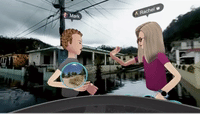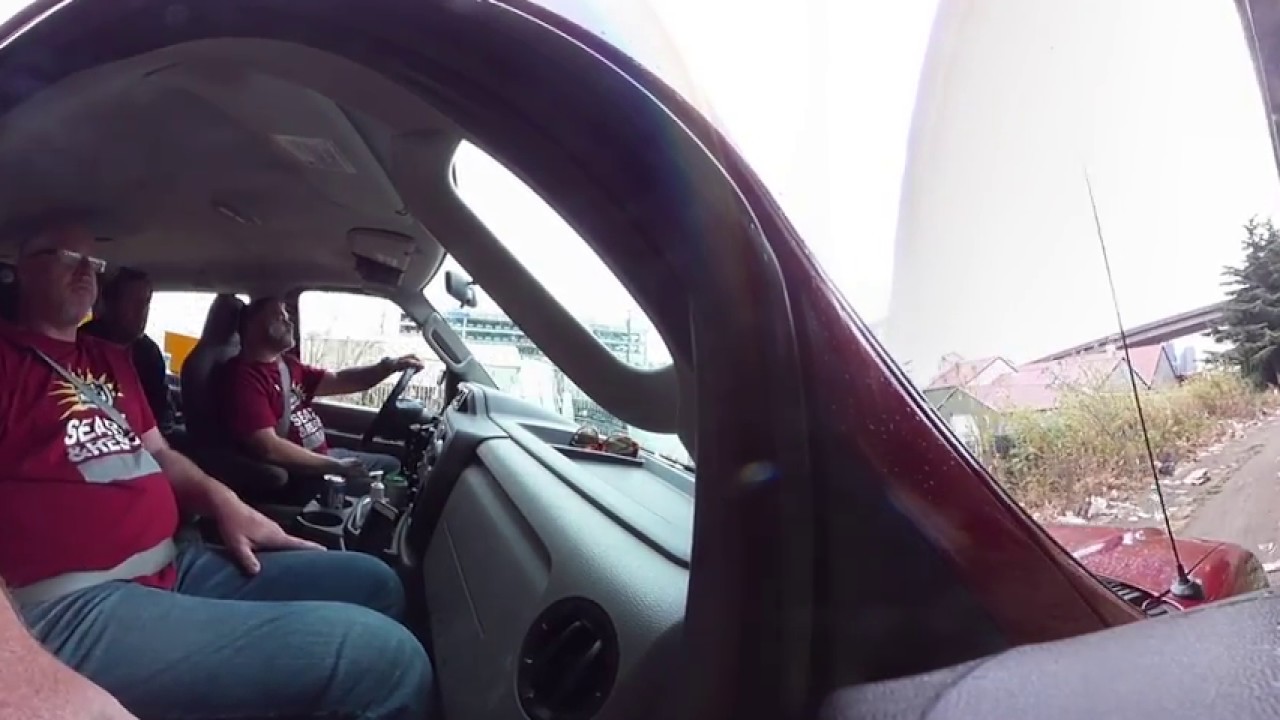On Monday, cartoonish versions of Facebook CEO Mark Zuckerberg and Facebook head of social VR Rachel Rubin Franklin took to the platform to demonstrate Spaces, part of Facebook’s push to make VR fun, accessible, and on Facebook. They did this by “teleporting” into Puerto Rico, currently a disaster zone, to trade high fives and news about the company’s disaster-relief efforts, their bobblehead avatars incongruous with the wreckage behind them.

Facebook/Ainsley Sutherland
But the impulse to illuminate humanitarian crisis using virtual reality wasn’t new. True believers love to tout virtual reality’s capacity as an “empathy machine,” an intimate, immersive, and human medium capable of transmitting human experience like no medium before it. Hunger in Los Angeles, VR forerunner Nonny de la Peña’s recreation of an emergency at an LA food bank, famously caused a user to cry as the headset was pulled off her face. In 2016, Oculus founder Palmer Luckey (who later left the company some time after his involvement in pro-Trump troll group “Nimble America” was exposed by the Daily Beast) even went so far as to extol the virtues of a VR future in which poor people could have everything wealthy people have…inside VR.
“Everyone wants to have a happy life,” Luckey told Wired in 2016, “but it's going to be impossible to give everyone everything they want …. Virtual reality can make it so anyone, anywhere can have these experiences.” At this point, technologists have used virtual and augmented reality to transport users into disaster zones, homeless encampments, date rape scenarios, and various additional sites of human suffering. (So have I.) It’s hard to get through an entire VR conference or pitch without hearing about empathy.
The “empathy machine” concept first reached the mainstream in a TED talk with VR guru and producer Chris Milk. In a presentation from 2015, Milk displayed a project, Clouds Over Sidra, which follows a young girl through a day in her life at a Syrian refugee camp in Jordan. The project is so canonical that Andrew Bosworth, head of AR/VR at Facebook, invoked it in response to the Spaces snafu.
Milk argues in his TED talk that because VR makes you feel as though you are sitting on the ground with Sidra, your attitude towards others will change. Presence, the logic goes, leads smoothly to empathy. Simply being there with Sidra in virtual reality is enough. It’s a nice thought, but it’s a leap of faith that allowed the industry to take a shortcut to proving its capacity for social impact and garnering mainstream appeal.
It helps, as always, to follow the money. Virtual reality faces two problems: first, the sexual harassment and assault scandals that have dogged it for years, and second, the pressing need to find users beyond gamers with $1,000-plus desktop computers. Empathy is a deus ex machina that conveniently solves both problems. Demonstrating that VR can be an engine for deeper understanding of the global human condition, and not just a vehicle for games and porn, isn’t just good PR — it’s an expansion of the number of potential users for the technology, and a salve for large companies like Facebook and Google that have made significant investments in the field but don’t want gamer culture dragging them down.
So VR has turned to journalism, documentary, nonprofits, and international development. By supporting media makers with storytelling experience, perhaps this technology can grow beyond its origins in fantasy gaming-rigs. And not all VR journalism is disaster porn: There are plenty of examples of more nuanced experiences that make use of the immersive qualities of the technology to augment a story with a physical or sensory element. After Solitary and 6×9, for example, both make good use of the headset to convey the isolation and captivity of solitary confinement.

Still from After Solitary
After Solitary / Via emblematicgroup.com
But VR content that takes users to disaster zones or on voyeuristic journeys into extreme poverty is of limited utility. The ideal, quantifiable outcome for many producers of these projects is donations. The United Nations VR group knows this, and is building an app that lets you donate without leaving a VR application. Is the success of such endeavors due to the novelty of VR? And how much longer before shock-jock-y VR filmmakers stream from disaster zones for Bitcoin tips unrelated to humanitarian goals?

Google Cardboards distributed to the UN General Assembly meeting during a discussion of refugees.
Via unvr.sdgactioncampaign.org
That said, there might be some truth to this “empathy machine” concept, though not in the way funders and audiences expect.
Empathy describes the process of how we go about understanding that other people have minds like our own. This concept, from social psychology, also has found some support from neuroscience, with the discovery of mirror neurons, which fire both when we perform an action and when we see an action being performed by another. However, although we know that something happens in us when we observe others and imagine their mental states, we don’t know what that something is. Empathy is the process, not the outcome. Though it is often linked simply to positive feelings and behaviors, we can also use empathy to more effectively cause pain, like a skilled bully.
The VR industry is operating with a muddy, unclear, superficial definition of empathy, one that is forgiving to truisms like “standing in another person’s shoes.” It’s also a definition that makes sense to a platform like Facebook, which offers connections and transparency and would prefer it if these characteristics eventually led to a “good” outcome. They don’t, and this misunderstanding of empathy results in product videos like the Facebook Puerto Rico clip, and elides the differences between reporting and voyeurism. One lesson we can take away from these missteps is that presence is not empathy, nor is emotion itself empathy. A better working definition might be that empathy arises when we ourselves change in relation to an object, person, experience — not just when we feel bad, or when we send money — but when we develop a new relationship to ourselves informed by that experience.
Empathy is the process, not the outcome.
The first wave of VR theory in the 1990s was not so explicitly tied to empathy as an end goal. Many of these artists and writers were concerned with “malleable body boundaries” and “new technologies of corporeality” — they wanted VR to create cyborgs, expanded consciousness, and new definitions of what it meant to be human. Maybe contemporary VR needs to let go of empathy as a goal, and start using it as a technique. Notes on Blindness, made as a VR accompaniment to a film of the same name, literally creates a visual language that emulates how someone with heightened aural senses perceives the world. In one section of this piece, the world appears and disappears around you, leaving visible only objects that are currently emitting a sound. It conveys an instability of environment that is deeply unfamiliar to sighted people, while still using a visual medium to do it.
This experience succeeds because it uses that process of empathizing — trying to understand what goes on in the minds of others — while it confounds our expectations around our own bodies, around what sight is. We emerge from it quiet and dry-eyed, hearing our world differently.
Ainsley Sutherland is a Boston-based media researcher and technologist, and 2015-16 BuzzFeed Open Lab Fellow.
Quelle: <a href="How Big Tech Helped Create The Myth Of The Virtual Reality Empathy Machine“>BuzzFeed

Published by